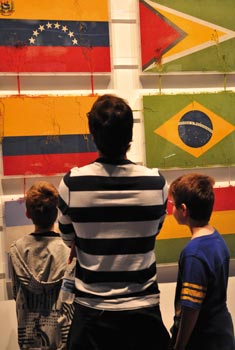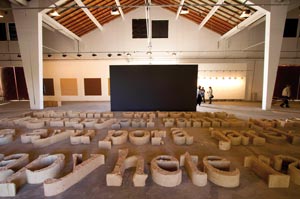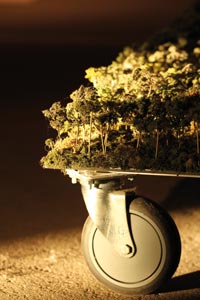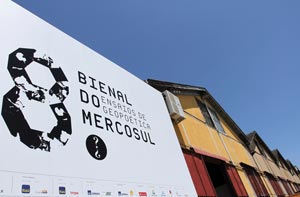The extensive social work geared towards the constructionof imaginaries and in mending local memories is the force that predisposed the art of the nineties, in Latin America, towards an epistemological direction, towards concerns cast on critical self-knowledge, stimulating in some creators an ontological obsession with identities as subjects of reflection.
Furthermore, since the continent’s different scenes share the signs of discontinuity, –cultural, political and territorial–, the notion of art as symbolic interface production becomes more critical, performing within the cracks of those discontinuities, operating with unstable trans-border cultural identities, and that is also likely to flow through trans-local networks such as collectors, galleries, Biennials, fairs, workshops and “clinics”, as well as through the specific circuits of museums and universities. In this exchange system different ways of assimilating modern processes and diverse historical and cultural heritages are mixed. Therefore it is necessary to rethink the creative sphere as a substantial part of the public sphere, which involves the state and civil society in the dialectic construction of citizenship and symbolic intergroup designs. However, the most dynamic production, transfer and circulation processes of contemporary art of our region tend to occur beyond institutionalism, lodging themselves in certain flexible and changing networks, which pursue from unexpected places the anachronistic inertia of the inherited state apparatus, resulting in a more dynamic para-institutional territory.
 In this sense the local scenes of art production and circulation do not fit the definition of “artistic field” established by Pierre Bourdieu’s sociology, as they have no precise institutional boundaries nor are they are governed by the field’s inherent power relations, but are the result of crossing over a given territory, of the different dynamics involved in the cultural industry, the social networks of citizenship involvement and formation, the level of enrollment in international market circuits, the traditions of regional symbolic production, among other circumstances .
In this sense the local scenes of art production and circulation do not fit the definition of “artistic field” established by Pierre Bourdieu’s sociology, as they have no precise institutional boundaries nor are they are governed by the field’s inherent power relations, but are the result of crossing over a given territory, of the different dynamics involved in the cultural industry, the social networks of citizenship involvement and formation, the level of enrollment in international market circuits, the traditions of regional symbolic production, among other circumstances .
These scenes are somehow subject to factors that act as regulatory elements (or regulators) derived from a territorial condition: a genius loci no longer understood an essentialist, immanent and static category, but as a creative concept that records meaning’s juxtapositions, palimpsest thatbears witness to the conflicts between local and global relations. If this local order tends to regulate local cultural, political and economic actors from its territory, global order bears on it a centrifugal and deregulatory force.
This bipolar essence not only becomes evident in the territories economic-administrative issues, but being mainly stress of symbolic nature, it is fully taken on by art practices, as they are potential carriers of a challenge to the seductive and anesthetic power of the metaphors operated by the market, that assert global neoliberal capitalism’s value system.
Then, what is the role of contemporary art’s production and circulation spaces of in relation to a territorial order Balkanized by market economy, and marked both by cultural diversification as well as the disintegration of its political spaces?
In order to address this point a partial historical overview of the issue seems pertinent.
The national intellectual elites were being established as the receptive support of European influences and agents of their local adaptation, shaping increasingly autonomous aesthetic spaces, that is to say, less attached to the political state space. Let’s take a close example: the first significant links between Rio Grande’s intellectual-field agents and politicized sectors of Uruguayan artists occur around 1952, when several artists and painters from Montevideo come in contact with Glenio Bianchetti and Glauco Rodrigues, who had just founded the Club of Gravura de Bage (Rio Grande do Sul, Brazil), which was taken as a model to establish the Engraving Club of Montevideo in 1953. The Montevideo- Bagé link proposed, in the mid-twentieth century, a techno-aesthetic platform: that of engraving as a media for the social redistribution of the educated middle class’ ideas, in correspondence with the Left’s political platform. That is, they proposed a specific relationship between artistic practices and politics, which to some extent reminded the historical tradition of cross-border Rio Grande sub-region relations of the nineteenth century.
Simultaneously there were close personal and doctrinal ties between Argentinean, Uruguayan and Brazilian artists. “Concrete art” proposed by the group of the Arturo magazine from the Rio de la Plata towards 1944, –in which the figure of Joaquín Torres García inserted in an ambiguous and controversial manner–, has a kind of conceptual counterpart in the early works of Brazilian artists Lygia Clark, Judith Lauand and Geraldo de Barros. Similarly, in the late forties, the social realism of the Brazilian painter Candido Portinari had an impact on Uruguayan and Argentinean painters almost fifteen years after the Mexican David Alfaro Siqueiros passed as a challenging burst by Rio de la Plata.
Indeed, the abstract-concrete artists were as interested in the social collective as any of the painters who cultivated political social realism. This is proven both by Argentinean “concretism’s” concern of inserting the artist in daily life’s material production, as by the concerns regarding the bonds between art and social psychology, with group pedagogy, and even with mental conditions. As the Argentinean group in its early stages met at psychoanalyst Enrique Pichon Riviere’s home; geometric Brazilian artists of the first period such as Mavigner and Serpa had worked during the forties in the “art and therapy” program of the Psychiatric Institute D. Pedro II; and in Uruguay the artist Maria Freire, –linked both to the Argentinean group as well as to the Brazilian concretists–, had begun her explorations in abstract art together with collective experiences that she carried out with her students of the Lyceum of Colonia del Sacramento after 1945.
 These facts confirm that the conception well into the fifties of a regional aesthetic space, took place under conditions that led to new ways of socialization of the artistic experience. This socialization went together with a deeper critical consciousness during a historical moment of final separation, in the region, of the aesthetic spaces’ significance and political spaces’ ideological nature.
These facts confirm that the conception well into the fifties of a regional aesthetic space, took place under conditions that led to new ways of socialization of the artistic experience. This socialization went together with a deeper critical consciousness during a historical moment of final separation, in the region, of the aesthetic spaces’ significance and political spaces’ ideological nature.
Today can we talk today about “aesthetic space” advocated by certain social sectors and marked by certain trends with doctrinal manifestos as happened up to the sixties? Obviously not. While the First Mercosur Art Biennial (Porto Alegre, 1997) arranged a historical review of doctrines and “trends” in regional art from 1930 to beyond 1970, as a critical and historiographical contribution to the formation, transformation and disappearance of the “aesthetic spaces” that took place in the South during that period, the Eight Mercosur Biennial (2011), studies the relationships between aesthetic space and territorial space realizing both areas’ balkanization converted to transit spaces: “with the title Geo-poetic Essays, the eighth edition of the Mercosur Biennial deals with territoriality and the its critical redefinition from artistic point of view. It brings together artists who create relevant works from geographical, political and cultural perspectives to discuss concepts of locality, nation, identity, territory, map and borders. The project includes the city of Porto Alegre [...] as a place to discover and activate through art”. These words of the Biennal’s main curator, Jose Roca, met, in his final sentence, with a strict requirement: “activate the city.”
There is no international Art Biennial in the world that does not have the primary mission of conferring political visibility to the host city, making it stand out on the economic and cultural, regional and global maps. The dimension that an event of this nature takes on is micro-local and transnational at the same time; it highlights the shifts of economic and political-administrative dynamics, from the orbit of the nation-state to the domain of cities, towns and their networks. Here it should be noted, however, funding for the Biennial’s and international Art Fairs doesn’t come mainly from state or municipal organizations, –that is to say political organizations–, but rather from the business and economic-financial private sector, whose interests have territorial bases in these cities.
What can be expected then, of the relations between contemporary art’s production and circulation systems and cultural integration systems embedded within a regional project such the one Mercosur aims to be the?
First, one wonders once again what degree of applicability have the intentions of the Mercosur Cultural Network, specified in a Ten Point program, so far had, one of whose central topics seems to have a more dynamic geographic and cultural interaction in the Region, understanding artistic creation and implementation of socio-cultural projects as a fundamental factor of integration. This concept is articulated with the geographical-cultural corridors, [...] the tool of choice to create alternative circuits of circulation of cultural goods that favor the formation of a regional cultural geography broader than that which constitutes the framework of Nation-States.
 The laudable part of these goals does not match with the real obstacles to implement them organically, since customs’ filters in the region, foreign ministries’ bureaucracy, lack of political will of regional bodies involved, and the relative balkanization of the cultural goods-producing agents, continue promoting administrative constraints that are practically insurmountable for the mobility of works of art, books, and even more so for traveling events. Everything tends to show that we are far away, as is well known, of achieving “free movement of goods and services”.
The laudable part of these goals does not match with the real obstacles to implement them organically, since customs’ filters in the region, foreign ministries’ bureaucracy, lack of political will of regional bodies involved, and the relative balkanization of the cultural goods-producing agents, continue promoting administrative constraints that are practically insurmountable for the mobility of works of art, books, and even more so for traveling events. Everything tends to show that we are far away, as is well known, of achieving “free movement of goods and services”.
The revitalization of the so-called “cultural corridors”, which has not matured anyfurther than being a point in the Mercosur program, but however becomes a spontaneous reality in the “border corridors”, which operate as genuine free trade zones, in which many elements combine: mestizo folk traditions, the most unusual media industry recycling, and where transitory identities are generated whose conflicts which are unpublished but are productive from a cultural point of view. Such is the case of the Argentine-Bolivian border, Argentine-Chilean, Uruguayan-Brazilian (with the “brasiguayos”) and the so-called “Triple Frontier” among others.[i]
It might be thought that the problem does not lie in the “obstacles” that certain factors impose on Mercosur’s cultural program, which most certainly exist, but rather in the fact that the program is “off the record”, it is out of place in regards to the realities of the region’s local scenarios. Without any previous program formulations, these scenarios take on culture’s socially binding function (in a broader sense than the urban “cultural field”) regardless of “cultural policies” and their alarming inefficiency, generating interactive areas that fall outside of Mercosur’s institutional framework.
The same thing happens with groups of artists versus state institutions, in which the former have undergone independent paths of trade, production and management; it happens among the producers of cultural goods of any nature in order to brave the empty gestures of Mercosur’s Cultural Network. The political and administrative authority needs to be increasingly flexible in order to give functional responses to the flow of ideas, production and circulation of these goods. However, the record so far shows that this flow’s dynamic space puts in evidence the rigidity of official structures that accompany them.
One way or another, regionalization goes hand in hand with decentralization, but while the latter has developed more or less simultaneously in the region in recent decades, the administrative barriers that remain (and in some cases have even increased) at national political borders, constitute a strong impediment to the extension and flexibility of the regionalization process. In other words, the progressive autonomy that local governments are requiring with autonomy in their relations beyond the national borders,[ii] draws a strategic diagram that when superimposed on the much more rigid state map with its political borders, sees its possibilities of integration weakened.
Moreover, recent events of importance as the Biennial of Porto Alegre since 1996, the Regional Art Meetings in Montevideo in 1993, 1996 and 2007, and the First Chilean Triennial in 2009 (not to consider in this case the legendary Sao Paulo Biennial), are specific milestones that do not guarantee the continuity of a cumulative exchange procedure, but create situations of mobility and interaction that strengthen the profile and productive density of local scenes –even with the difficulties involved in transferring cultural property between territories–, as they provide the possibility of renewed exchanges among both those who produce and distribute cultural goods as well as between the agents of knowledge production at the international and sub-regional levels. While these “independent” initiatives are gaining strength notwithstanding the regional bloc’s institutionalized bureaucracy, the Ministers of Culture of these countries for the last fifteen years (since 1996) have been discussing about the Mercosur Seal without knowing why or how to put it into practice.
 To come to the point, what we are talking about is that artistic production contribute, –in its specific symbolic dimension–, to build a regional public sphere. The role of the media, the culture industry and contemporary art production are contributing factors of particular relevance in the construction of this sphere, since trade, business, political and diplomatic links encouraged by Mercosur do not create a “region”, in the fundamental sense of this concept, since they do not strongly stimulate the circulation of ideas and cultural goods, the movement of groups and individuals promoting inter-ethnic encounters, nor roaming special events, workshops of artistic and literary production, open call exhibitions and seminars, as well as seminars to sponsor the connection between academic levels committed to transversal cultural studies in the region.
To come to the point, what we are talking about is that artistic production contribute, –in its specific symbolic dimension–, to build a regional public sphere. The role of the media, the culture industry and contemporary art production are contributing factors of particular relevance in the construction of this sphere, since trade, business, political and diplomatic links encouraged by Mercosur do not create a “region”, in the fundamental sense of this concept, since they do not strongly stimulate the circulation of ideas and cultural goods, the movement of groups and individuals promoting inter-ethnic encounters, nor roaming special events, workshops of artistic and literary production, open call exhibitions and seminars, as well as seminars to sponsor the connection between academic levels committed to transversal cultural studies in the region.
On some occasion it was suggested[iii] that the “cultural sector” is primarily responsible for failing to find effective administrative mechanisms to carry out the agreements on culture that were signed at Mercosur. However, beyond the existing operational inertia and myopia of many cultural institutions, the truth is that there is no “cultural sector” as such, except in the imagination of cultural policies that build virtual territories to procure their strategies. There is no cultural sector because the field of production of goods and services in that rank is not, -and should not have to be-, systematically corporatized. And much less in the case of artistic practices, since such actions are isolated and not always interconnected, –though unintentionally converging on constitutional aspects of subjectivity and social behavior–, tend to generate ephemeral networks and dynamic fields of interaction, not susceptible of being enrolled in the institutional order of society’s alleged “cultural sector”. And it’s not a problem either of Mercosur’s “cultural policies”. Renato Ortiz noted, in more than one occasion, the conceptual distance between cultural policy as a strategy of the “hard” institutions, and the cultural sphere as a “soft” field, forming and binding a society. The role of artistic production is associated precisely with the latter space, capable of carrying out a mending social function, producing “other” subjectivities. Clearly, this production is at risk of being channeled through “cultural” policies’ conventional means, or of being used as a prestige vehicle by the policies of economic diplomacy.
“No cultural policy can be carried out without first asking ourselves: of what type of development are we talking about? There is no single answer to this, and we are face by a ring of difference of opinions for the monopoly of the definition”.[iv] The concepts of sustainable and comprehensive development, which have sought to incorporate human and ecological issues in the core of capitalist development, are mere nominalisms that fail to hide the blind linear development process led by global economy with all the destructive consequences that this process provokes at local levels, now under military control of the euphemistically called “low intensity” neo-imperialist war strategies.
In this context, art does not accompany economic development. Furthermore, art does not even have anything to do with the so-called sustainable development, other than having the opportunity of becoming its most stinging critical pole. Indeed, contemporary creativity may manifest itself as the critical alternative of that development which is based on profit appropriation (no matter the degree of distributive justice that may exist) and the accelerated imbalance generated on the global ecosystem by the technological race.
Today, more than ever, art and intellectual production have become valued resources of market economy,[v] but on the other hand, have become resources of power in the realm of ideas and symbolic transactions. At the same time a production plant, becomes a trading corridor that mixes different ways of assimilating modern processes and diverse historical and cultural heritage of regional character. This makes of artistic practices a particularly suitable area to fulfill, on the one hand, mediation functions related to inter-ethnic and inter-cultural aimed at social inclusion and networking of local scenes; but on the other hand, it they are also the best means to criticize the system to the extent in which they will be able to propose a constructional logic for subjectivity and the production of meanings, radically opposed to the marketing the values of neo-liberalism in its present stage.
In this sense, the construction of a regional public sphere should be carried out without reluctance in the staging of these conflicts. Current art’s domestication occurs when it is reduced to a prestige vehicle subject to cultural diplomacy’s circuits, or a sort of “free zone” for appeasement and acquiescence, where the most dramatic social tensions could be turned into goods of consumption for time and the leisure industry. Regionally, the latter would involve, additionally, the risk of attempting art’s return to local telluric characterizations. However, “regionalizing” art practices means, undoubtedly, something else: is given the task to return the locus logos fractured and fragmented body of our current societies without turning our backs on global processes, and without tellurizing the place, as countless new ways of feeling territorial belonging have emerged, defined by affective and communicational bonds not necessarily derived from real roots. That is supposing that all in all, those practices take on as their own the changing field of obstacles and conflicts whose boundaries constantly redraw the emerging regional public sphere.
Since the late nineteenth century art has been considered by the political class by liberal institutions, and even the positivist philosophy, as an ornament of grace, as the aesthetic territory in which a certain type of social enjoyment that clears or neutralizes conflicts takes place; as a field dependent of discipline and social distinction. This approach, despite appearing outdated in the field of art theory and practice from long ago, still exists today sheltered under a fetish market and a global middle class reliant on business logic and diplomatic strategies. In this situation, local policies, would be able to foster a trans-local counter-culture[vi] opposing that model, and therefore, fostering the development of artistic practices, whose regional projection predisposed to a new kind of artistic autonomy, and not any longer in the sense that the historical avant-garde assigned them, but in the sense of autonomy aimed at the construction of their own public, intercultural dialogue in poetic clef, the production of critical and reflective subjectivities, questioning a market system that anaesthetizes and obliterates the visibility of the conflicts that it itself generates.
If we accept the notion of market in its broadest sense, not restricted to the field of economics, but in reference to all the areas of society in which primarily symbolic transactions occur, that is, if we accept that the market is a transaction space in which they play, through market mechanisms, essentially cultural values, we should adopt this critical perspective to address the problem of Mercosur not only as a strictly commercial region, –and so it is raised at the declaratory level–, but, above all things, –and according to the indisputable historical background in this sense–, cultural and political basin in which a special status is acquired by what we may call the “Rio Plata cultural basin” sub-region. This is not a rigid concept; it’s about a place from which to look at the regional and global problem as a place of transitions and transgressions; as an encounter of “other” modernisms, –which carry their own historical legacy–, with the agents of imported postmodernisms; as a crossroads of ethnic and linguistic complicity that in the presence of global friction generate their own configurations in the field of artistic and cultural practices in general.
June 2011
[i] ALEJANDRO GRIMSON, comp.: Fronteras, naciones e identidades. La periferia como centro, Ediciones La Crujía, Buenos Aires, 2000.
[ii] A favorable event in this sense is the Network of Merco-cities that is in development since 1995.
[iii] GONZALO CARÁMBULA: “¿Por qué no se usa el sello Mercosur Cultural?”. In GERARDO CAETANO, comp.: MERCOSUR 20 años, CEFIR, Uruguay, 2011, p 192.
[iv] RENATO ORTIZ:Presentation at the V Euroamerican Cultural Cooperation Campus, Almada, Portugal, 2007.
[v] GEORGE YÚDICE:El recurso de la cultura. Usos de la cultura en la era global, Editorial Gedisa, Barcelona, 2002.
[vi] JAMES CLIFFORD: Itinerarios transculturales. Editorial Gedisa, Barcelona, 1999, pág.18.
Related Publications

How Harumi Yamaguchi invented the modern woman in Japan
March 16, 2022












